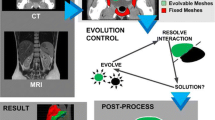Abstract
Among the segmentation methods proposed in the literature, the active contour models have been widely used in medical images segmentation. This is due to their efficiency to capture complex shapes. Nevertheless, the adequate set of the initial curves for active contours is needed to lead to good automatic segmentation results. An adequate initialization method should set the initial active contour model close enough, to the final targeted boundary, to avoid local minima and to improve computational efficiency. In this paper, we present a new approach, based on the divergence of vector field and the Dijkstra’s algorithm to automatically initialize and give the B-Snake the ability to change topology in presence of multiple objects very close to each other. The divergence of vector fields informs about the vectors spread. Negative divergence indicates that the vectors converge and positive divergence indicates that the vectors diverge. Thus, we used the negative region of the divergence of the vector field convolution (VFC) to set the initial active contour near the objects and the positive divergence region was used to split the B-Snake via Dijkstra algorithm. To demonstrate the effectiveness of the proposed method, we use computed tomography (CT) images of close bones. This method gives good segmentation results, especially on CT images presenting proximities, compared to results obtained by other automatic segmentation methods from the literature.











Similar content being viewed by others
References
Kass, M., Witkin, A., Terzopoulos, D.: Snakes: active contour models. Int. J. Comput. Vis. 1(4), 321–331 (1988)
Amini, A.A., Weymouth, T.E., Jain, R.C.: Using dynamic programming for solving variational problems in vision. IEEE Trans. Anal. Mach. Intell. 12(9), 855–867 (1990)
Kang, D.J.: A fast and stable snake algorithm for medical images. Pattern Recognit. 20(5), 507–512 (1999)
Menet, S., Saint-Marc, P., Medioni, G.: B-Snakes: Implementation and application to stereo. In: Proceedings of the Image Understanding Workshop, Sept. 1990, pp. 720–726 (1990)
Charfi, M., Zrida, J.: Speed improvement of B-Snake algorithm using dynamic programming optimization. IEEE Trans. Image Process. 20(10), 2848–2855 (2011)
Cohen, L.D.: On active contours models and balloons. Comput. Vis. Graph. Image Process. Image Underst. 53, 211–218 (1991)
Cohen, L.D., Cohen, I.: Finite-element methods for active contour models and balloons for 2-d and 3-d images. IEEE Trans. Pattern Anal. Mach. Intell. 5(11), 1131–1147 (1993)
Xu, C., Prince, J.L.: Generalized gradient vector flow external forces for active contours. Signal Process. 71, 131–139 (1998)
Xu, C.: Deformable Models with Application to Human Cerebral Cortex Reconstruction from Magnetic Resonance Images. Phd thesis, Department of Electrical and Computer Engineering, Johns Hopkins University, Baltimore, MD, 21218, USA (1999)
Hsu, C.Y., Chen, S.H., Wang, K.L.: Active contour model with a novel image force field. In: 16th IPPR Conference on Computer Vision, Graphics and Image Processing, 17–19 Aug, pp. 477–483 (2003)
Li, C., Liu, J., Foxa, M.D.: Segmentation of external force field for automatic initialization and splitting of snakes. Pattern Recognit. 38, 1947–1960 (2005)
Li, B., Acton, S.T.: Active contour external force using vector field convolution for image segmentation. IEEE Trans. Image Process. 16(8), 2069–2106 (2007)
Osher, S., Sethian, J.: Fronts propagating with curvature-dependent speed: algorithms based on the Hamilton-Jacobi formulation. J. Comput. Phys. 79, 12–49 (1988)
Caselles, V., Catte, F., Coll, T., Dibos, F.: A geometric model for active contours in image processing. Numer. Math. 66(1), 1–31 (1993)
Malladi, R., Sethian, J.A., Vemuri, B.C.: Shape modeling with front propagation: a level set approach. IEEE Trans. Pattern. Anal. Mach. Intell. 17(2), 158–175 (1995)
Tsitsiklis, J.: Efficient algorithms for globally optimal trajectories. IEEE Trans. Autom. Control 40, 1528–1538 (1995)
Adalsteinsson, D., Sethian, J.: A fast level set method for propagating interfaces. J. Comput. Phys. 118(2), 269–277 (1995)
Adalsteinsson, D., Sethian, J.: The fast construction of extension velocities in level set methods. J. Comput. Phys. 148(1), 2–22 (1999)
Sethian, J.: Level Set Methods and Fast Marching Methods. Cambridge University Press, Cambridge (1999)
Min, C.: On reinitializing level set functions. J. Comput. Phys. 229(8), 2764–2772 (2010)
Li, C., Xu, C., Gui, C., Fox, M.D.: Distance regularized level set evolution and its application to image segmentation. IEEE Trans. Image Process. 19(12), 3243–3254 (2010)
Ge, X., Tian, J.: An automatic active contour model for multiple objects. In: Proceedings 16th International Conference on Pattern Recognition, vol. 2, pp. 881–884 (2002)
Tauber, C., Batatia, H., Ayache, A.: A general Quasi-automatic initialization for Snakes: application to ultrasound images. IEEE Int. Conf. Image Process. 2, 806–809 (2005)
Li, B., Acton, S.T.: Automatic active model initialization via Poisson inverse gradient. IEEE Trans. Image Process. 17(8), 1406–1420 (2008)
Selvadurai, A.P.S.: Partial Differential Equations in Mechanics 1: Fundamentals, Laplace’s Equation, Diffusion Equation, Wave Equation, Chapter 1.1. Springer, Berlin (2000)
Margolin, L.G., Shashkova, M., Smolarkiewiczb, P.K.: A discrete operator calculus for finite difference approximations. Comput. Methods Appl. Mech. Eng. 187(3–4), 365–383 (2000)
Sukumar, N., Bolander, J.E.: Numerical computation of discrete differential operators on non-uniform grids. Comput. Model. Eng. Sci. x(x), 1–15 (2003)
Kroon, D.J.: Segmentation of the Mandibular Canal in Cone-Beam CT Data. PhD thesis, Signals & Systems group, EEMCS Faculty, University of Twente, ISBN 978-90-365-3280-8, Netherlands (2011)
Dijkstra, E.: A note on two problems in connexion with graphs. Numerische Mathematik 1, 269–271 (1959)
Acknowledgments
The authors thank Dr. Béchir Abdelmoula of the Ibn Zohr Center of Radiology of Tunis for providing the CT medical image data.
Author information
Authors and Affiliations
Corresponding author
Rights and permissions
About this article
Cite this article
Bakir, H., Charfi, M. & Zrida, J. Automatic active contour segmentation approach via vector field convolution. SIViP 10, 9–18 (2016). https://doi.org/10.1007/s11760-014-0695-7
Received:
Revised:
Accepted:
Published:
Issue Date:
DOI: https://doi.org/10.1007/s11760-014-0695-7




